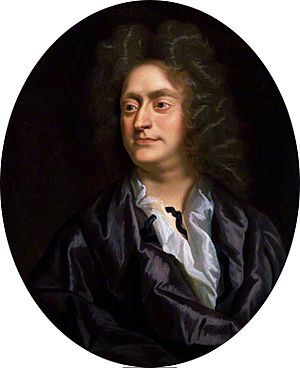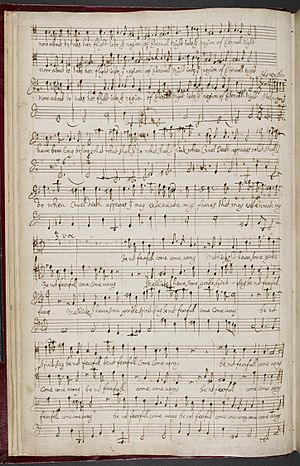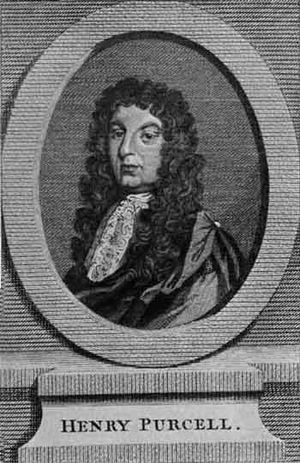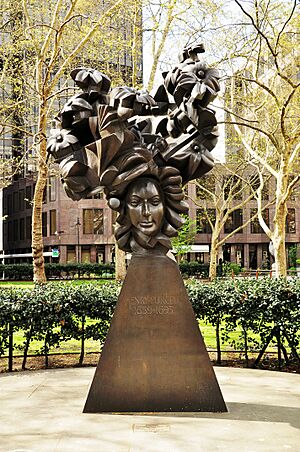Henry Purcell facts for kids
Quick facts for kids
Henry Purcell
|
|
|---|---|

Portrait by John Closterman, around 1695
|
|
| Born | c. 10 September 1659 Westminster, London, England
|
| Died | 21 November 1695 (aged 36) Marsham Street, London, England
|
| Spouse(s) |
Frances Purcell
(m. 1682) |
| Children | 6, including Edward |
| Relatives | Edward Henry Purcell (grandson) |
Henry Purcell (born around 10 September 1659 – died 21 November 1695) was a famous English composer. He created music in the Baroque style, which was popular in Europe from about 1600 to 1750.
Purcell's music had a special English sound, but it also used ideas from Italian and French music. Many people think he was one of the greatest English opera composers ever. He is often mentioned with John Dunstaple and William Byrd as one of England's most important early composers. No other English composer became as famous as Purcell until much later, in the 20th century.
Contents
About Henry Purcell
His Early Life
Henry Purcell was born in Westminster, London, in 1659. This area was known as a poor part of the city. His father, Henry Purcell Senior, was a musician who sang for King Charles II of England. Henry Senior had three sons: Edward, Henry, and Daniel. Daniel Purcell, Henry's younger brother, also became a composer.
When Henry's father died in 1664, his uncle Thomas took care of him. Thomas was very kind and helped Henry become a chorister, which is a singer in a church choir. Henry first studied music with Captain Henry Cooke, and then with Pelham Humfrey. The composer Matthew Locke was a family friend and likely influenced young Henry's music. Henry sang in the Chapel Royal until his voice changed in 1673. After that, he became an assistant to an organ-builder.
His Music Career
Purcell is thought to have started composing music when he was only nine years old. His earliest known work is an ode (a type of poem set to music) for the King's birthday, written in 1670 when he was eleven. After Humfrey died, Purcell continued his studies with Dr John Blow. He also went to Westminster School. In 1676, he became a copyist at Westminster Abbey, meaning he copied musical scores.
In 1679, Purcell wrote songs for a music book called Choice Ayres, Songs and Dialogues. He also wrote an anthem (a piece of sacred music) for the Chapel Royal. This anthem was for a singer named John Gostling, who had an amazing deep voice. Gostling's voice could sing very low and very high notes. Purcell wrote several anthems for Gostling's special voice. One famous example is They that go down to the sea in ships. This piece was written to celebrate King Charles II surviving a shipwreck. It starts with a very challenging part that uses Gostling's full vocal range.
Between 1680 and 1688, Purcell wrote music for seven plays. During this time, he also composed his famous chamber opera Dido and Aeneas. An opera is a play where the story is told mostly through singing. This opera was performed in 1689 at a boarding school for young women in Chelsea. Dido and Aeneas is sometimes called the first true English opera. Unlike many plays, the characters in this opera sing their lines instead of speaking them. The story comes from an ancient Roman poem called the Aeneid.
In 1679, John Blow stepped down as organist of Westminster Abbey, and Purcell took his place. For the next six years, Purcell focused mostly on writing sacred music (music for church).
Soon after Purcell got married in 1682, he also became the organist of the Chapel Royal. He held both jobs at the same time. His first printed music, Twelve Sonatas, was published in 1683. He continued to write many sacred pieces and odes for the King and royal family. In 1685, he wrote two beautiful anthems, I was glad and My heart is inditing, for the crowning of King James II.
In 1687, Purcell started writing music for plays again. He composed music for John Dryden's play Tyrannick Love. He also wrote a popular march called Quick-step. In 1690, he composed music for Dioclesian and Amphitryon. In 1691, he wrote music for what many consider his best dramatic work, King Arthur. In 1692, he composed The Fairy-Queen, which was based on Shakespeare's A Midsummer Night's Dream. This was his longest piece of music for the theatre.
In these "semi-operas" or "dramatic operas," the main characters in the plays speak their lines instead of singing. The songs are sung by other singers who have smaller roles.
Purcell's Te Deum and Jubilate Deo were written in 1694 for Saint Cecilia's Day, a celebration of music. This was the first English Te Deum ever written with a full orchestra. It was performed every year at St Paul's Cathedral for a long time.
His Death
Purcell died in 1695 at his home in London. He was only 35 or 36 years old. The exact reason for his death is not known. Some people say he got sick after being locked out of his house on a cold night. Others believe he died from tuberculosis.
Purcell was buried next to the organ in Westminster Abbey. The music he had written for Queen Mary's funeral was played at his own funeral. People all over England were sad about his death. His tombstone says: "Here lyes Henry Purcell Esq., who left this life and is gone to that Blessed Place where only His harmony can be exceeded."
Purcell had six children with his wife, Frances, but four of them died when they were babies. His wife and two children, Edward and Frances, survived him. His wife Frances published many of his works after he died, including a famous collection called Orpheus Britannicus.
Purcell's Legacy
Famous Compositions
Purcell wrote many different kinds of music. He composed pieces for the royal court, like symphony songs, and for the Chapel Royal, like symphony anthems. He also wrote a lot of music for the theatre.
Some of Purcell's most famous works include his opera Dido and Aeneas (1688), and his semi-operas Dioclesian (1690), King Arthur (1691), and The Fairy-Queen (1692). He also wrote important pieces like Hail! Bright Cecilia (1692), Come Ye Sons of Art (1694), and the Funeral Sentences and Music for the Funeral of Queen Mary (1695).
His Influence and Reputation
After Purcell died, many other musicians and writers honored him. His friend John Blow wrote an ode about his death. Another composer, William Croft, used Purcell's music in his own work, saying it was "obvious to any artist" why he did so. Purcell's setting of "Thou knowest Lord" has been sung at every British state funeral since.
Purcell also greatly influenced English composers in the 20th century, especially Benjamin Britten. Britten arranged many of Purcell's songs and based his famous piece The Young Person's Guide to the Orchestra on a theme from Purcell's music.
In 1940, a famous pianist named Ignaz Friedman said he thought Purcell was as great as Bach and Beethoven. In London, there is a bronze statue of Purcell that was put up in 1995 to mark 300 years since his death. In 2009, the Royal Mail even put Purcell on a special postage stamp!
A club called the Purcell Club was started in London in 1836 to perform his music. Today, there is a modern Purcell Club that offers tours and concerts at Westminster Abbey. There is also a Henry Purcell Society in Boston, USA, and a Purcell Society in London that studies his music.
Purcell's works have been listed by a person named Franklin B. Zimmerman, who gave each piece a "Z" number. For many years, a popular wedding song called Purcell's Trumpet Voluntary was wrongly thought to be by him. It was actually written by another British composer, Jeremiah Clarke, around 1700.
Images for kids
See also
 In Spanish: Henry Purcell para niños
In Spanish: Henry Purcell para niños










